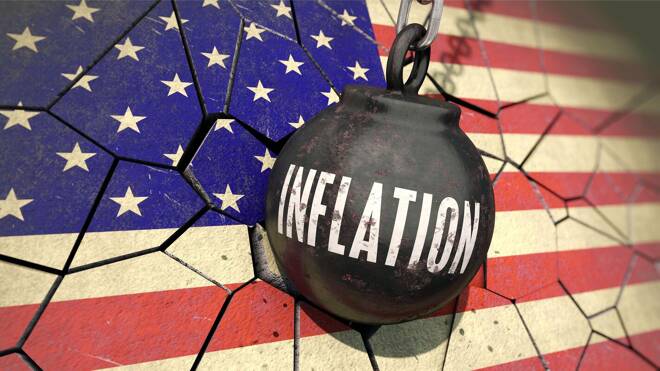Advertisement
Advertisement
USD/JPY, WTI Oil – Markets React to Rising Prices in the US
By:
The market desperately needs terrible economic news to stabilize as post-pandemic era continues to deliver unusual macroeconomic patterns.
US stocks traded notably lower Friday before recovering some lost ground into the close as investors reacted to more evidence that inflation may have ticked up again in January, pressuring rates higher and weighing on stock valuations.
US Stocks React to Higher Inflation and Pressure on Rates
Friday’s higher-than-expected PCE inflation reading seems to confirm what we saw in last week’s high PPI wholesale inflation report — that is that prices are continuing to rise in the US and that the rate of increase may not be receding as fast as it had been last fall (if the rate is receding at all). Core PCE rose by 0.57% in’ January, up from 0.37% a month earlier.
Day-by-day and brick-by-brick, the terminal rate has been pushing higher in a manner that generally was not intimidating for the stock market until it was when velocity kicked in, hurting long-duration parts of the market, which eventually lost their immunity to higher rates as the month wore on. And compounding matters,
Fed speaks been tilted towards the need to do more. Now market participants are not discriminating between traditional hawks and doves; instead, they are letting the searing inflation data do the bulk of the talking.
The most significant move across the macro landscape occurred in the most critical asset of them all — US interest rates — which featured a notable break higher in US yields.
But the post-pandemic era also carries with it sustained elevated market volatility, uncertainty, and even a bit of trepidation. The VIX sits at 22 still — having resided in the low-to-mid-teens for much of the pre-pandemic decade. And this trepidation may mean that many market participants can only trade what they are seeing today, even if patterns suggest what they are seeing may soon fade.
It could be difficult for the market to find much comfort ahead of Chair Powell’s testimony ahead of the blackout period.
However, suppose incoming data show some mean reversion, and then the policy path becomes more anchored to a 5.25-50 terminal rate; in that case, the market could be approaching the US economic/Fed-driven dollar demand limit.
Given the extent and speed of the repricing, the market has already priced a fair amount of good growth/ higher inflation news.
It will need upcoming data releases to confirm before yields can establish another material leg higher. Near-term, this suggests that results could consolidate somewhat, and the risk/reward of staying short bond long USD is not compelling.
It’s hard to believe I’m typing this, but this market desperately needs terrible economic news.
We have been down this path before. We experienced similar ‘1-month’ spikes last June and August, followed by subsequent inflation cooling. The post-pandemic era continues to deliver unusual macroeconomic patterns.
FOREX
While we had initially thought Asia FX would be relatively buffered on any US dollar sell-off due to the China reopening, with the market and policymakers starting to reassess how much tightening might ultimately be required to tame the inflation beast, risks are increasing for yet another leg higher for the USD, which could be indiscriminate amid heightened geopolitical risk which has seen China betas and pro-growth trades unwind.
USDJPY typically rallies when US real yields rise, with the broader risk backdrop taking a back seat. In other words, higher US gains trump JPY safe-haven demand when global stocks are selling off.
BoJ Ueda will likely focus on retreating for YCC but will avoid any big shocks to the economy before adopting a more traditional policy framework around controlling short-term rates. Hence the BoJ’s next step is likely to shorten the target duration of YCC to 5 years from 10 years.
OIL
Despite a US inventory glut and increasing demand for the safe-haven US dollar amid risk-off, oil prices rallied ahead of this week’s official and Caixin manufacturing PMIs, which should provide further evidence of China’s reopening surge. But the primary overhang could be higher inventories that hang like an anvil over market participant heads.
And with the NPC just around the corner and given that growth is a top priority, the market could position long oil for a pro-growth party congress.
NPC PREVIEW
The reaction of the RMB will likely depend on which scenario plays out during the NPC. On the more constructive end, if the government were to fire on all policy cylinders, this would likely be very positive for risk assets. It would drive strong RMB appreciation, and strong policy stimuli would probably turn risk sentiment around, particularly for Asian FX.
On the other hand, if the government were to maintain the status quo, i.e., a marginal increase in fiscal stimuli, the market would likely remain cautious about China’s recovery. As a result, RMB would likely continue to underperform and stay at the mercy of the USD outlook.
In equities, the sell-off from overbought levels is essentially over. And now is the time to add positions before the NPC, as mainland investors remain cashed up and ” long-onlies” are underweight, especially outside the internet space. This sets the market up to rally even in a mildly favorable policy scenario. Should any structural reform be announced, that would likely be favorable to a more sustained rally.
About the Author
Stephen Innescontributor
With more than 25 years of experience, Stephen Innes has a deep-seated knowledge of G10 and Asian currency markets as well as precious metal and oil markets.
Advertisement
